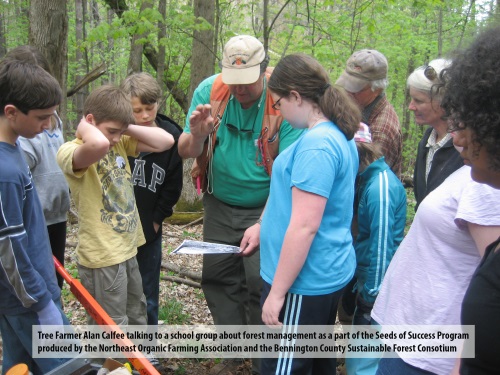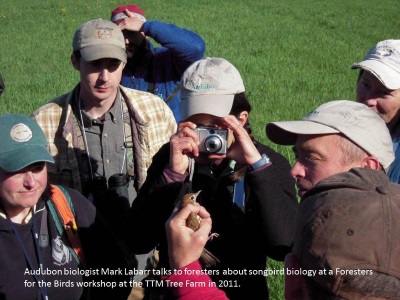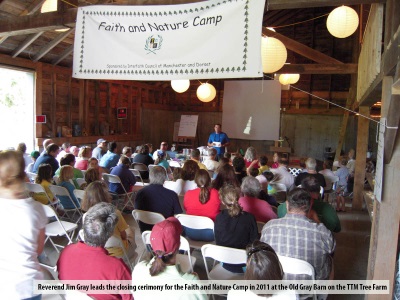Alan Calfee of Vermont

What makes them outstanding?
Mr. Calfee has been practicing and promoting sustainable forestry for more than 25 years on his family’s 591-acre Tree Farm, where he is trying to turn around a legacy of high-grading through timber stand improvement and crop tree release; through professional affiliations such as Vermont Coverts (he is president), Forest Guild (he was a founding member and now serves on its board), and as a founding and advisory board member of the Bennington County Sustainable Forest Consortium; on the more than 20,000 acres his consulting firm manages in the Northeast; and through his teaching and outreach to audiences of all ages and backgrounds. Mr. Calfee recognizes and relies on the power of collaboration and partnerships, no matter the challenge as is evidenced by his tireless efforts to educate laypersons about invasive plant species, or his successful securing of funds to conserve an iconic summit in southwestern Vermont. He brings great skills and energy to the practice of sustainable forestry. He believes what he does was best described by a middle-schooler, who, when asked what she thought he did for a living, said foresters take care of the stuff. Indeed, Alan takes care of the stuff.
Tree Farmer Story

In 2001, a 450 acre parcel in the Mettowee Valley of southwestern Vermont appeared destined to be converted from agriculture and forest to residential use. The then owners did not want to leave the land but could no longer afford ownership and a developer had been lined up to purchase the property. When Alan Calfee, his mother June Davis and stepfather Peter Davis learned of this they saw a huge opportunity.
As TTM Associates (The Three Musketeers), Alan, June and Peter worked with the landowner to subdivide out the homestead and a lot for the their son so they could remain on the land. TTM purchased the remaining 100 acres of farm fields and 342 acres of forest. A 149 acre adjoining parcel of forestland was purchased from an industrial timberland owner in 2005.
The Calfee/Davis family has a long-held interest in land conservation and according to Calfee, the TTM project represents the culmination of one family’s interest and commitment to land stewardship, conservation and spreading the word about good forestry. In 2001, Calfee had already been a professional forester for nearly 20 years and his family had owned and managed a smaller woodlot. The new parcel offered many more possibilities.
While TTM Associates got to know the property, it became clear the history of the land would dictate management in the immediate future. The woodland had been heavily cut-over. The landowner objectives and management plan focused on restoration. For Calfee, the restoration effort, and his career, harkens back to his early years. From an early age his mother shared with him the importance of stewardship and a healthy reverence for the amazing complexity of life. Less pleasant was a lesson learned about forestry through the misguided cutting of an unscrupulous logger. When Calfee was fourteen, the woodlot he had grown up on was high-graded and the logger stole most of the revenue from the harvest. It was at that point, Calfee says, that I realized there has to be a better way!
The agricultural portion of
the TTM property continues in active use through leases to two local farmers.
Open land that was becoming overrun with non-native, invasive plants has  been
reclaimed. In the forest, invasive plants populations have been reduced. Tree seedlings were planted along the
Mettowee River to increase the riparian buffer and help improve water quality
and wildlife habitat. Patch cuts have been carried out in an attempt to improve
the range of wildlife habitat and establish acceptable growing stock. Small
improvement cuts have been executed to improve growing conditions and stimulate
growth in the understory. Firewood has been produced for the owners and several
neighbors.
been
reclaimed. In the forest, invasive plants populations have been reduced. Tree seedlings were planted along the
Mettowee River to increase the riparian buffer and help improve water quality
and wildlife habitat. Patch cuts have been carried out in an attempt to improve
the range of wildlife habitat and establish acceptable growing stock. Small
improvement cuts have been executed to improve growing conditions and stimulate
growth in the understory. Firewood has been produced for the owners and several
neighbors.
For the owners, equal to the improvements that have been made to the land is the use of the property for educating on the topics of nature, sound forestry and land management practices and to create connections between people and the land. The property has been a venue for numerous workshops for resources professionals and landowners on a range of topics. Partners on these workshops have included Audubon Vermont, Bennington County Sustainable Forestry Consortium, Vermont Land Trust, The Nature Conservancy and the Vermont Woodlands Association. These workshops used the forest on the property as an outdoor classroom to put workshop topics in context. Sometimes the educational opportunities are not only theoretical. Two Game of Logging courses have taught chainsaw safety through active cutting by participants.
Two, somewhat non-traditional educational opportunities have also become regular events. Green Mountain College uses the property as a base for a week-long camp for natural resource majors and the local Congregational Church hosts a week-long Faith and Nature Camp for local youth. At the closing ceremony each year of the Faith and Nature Camp, the TTM owners hear of lessons learned by the campers. It is during these ceremonies,” says Calfee, “that we really see that we are achieving our vision of sharing our piece of land with people.”
The functionality of the property for education is supported by the presence of a large, old barn to host indoor portions of events. Like much of the forest, when TTM tenure began, the barn was in poor condition but has been restored and named The Old Gray Barn. As well as hosting workshops, The Old Gray Barn has become a popular space for weddings, birthdays and other social events, particularly for locals. Local residents also use the property to fish, hike Scallop Mountain, ride mountain bikes, ski, watch birds and walk dogs.
Improving the agricultural, open and forestland on the property as well as playing a role in educating and connecting folks with the land are main objectives for the property. The landowners also try to consider the property in the landscape context. An easement was placed on all the agricultural and a portion of the forestland through the Vermont Land Trust with the goal of helping preserve the bucolic nature and aesthetic of the Mettowee Valley. TTM collaborates with a group of neighboring landowners to manage the wildlife management area that encompasses about 1600 acres. Permits are given to individuals to hunt on the properties. This arrangement preserves the local hunting culture while giving TTM a tool with which to respond to deer impacts on forest regeneration.
Except for some invasive control, the woods work on the property has been carried out by Calfee or his forestry company and Calfee has helped organize many of the workshops. Sometimes Calfee is intimidated by the amount of work to be done on the property to fully meet his and his parents’ objectives for the property, but he’s happy to keep plugging away knowing that they’re making a difference, on many levels. As Calfee said in accepting the 2014 Vermont Tree Farm of the Year Award, “This forest is a place where people come to gather to celebrate, learn, and just enjoy the beauty and wonders of the natural world. It is also a bully pulpit to broadcast the message of sound management of Vermont’s forests and wildlife”.
Wood
The TTM property has a detailed long term forest management plan and is enrolled in Vermont’s Use Value Appraisal Program (UVAP). The program reduces property taxes by taxing agricultural and forest land on its current use, not its highest or most valuable use. Forestland enrolled in the UVAP must be managed according to a State-approved management plan that focuses on the production of forest products on a sustainable basis.
Sustainable production of high quality hardwood sawlogs and veneer is one of the objectives of the management for the woodlands on the property. The property was high-graded heavily in the two decades prior to TTM ownership, so quality growing stock is limited in the mature stands. Therefore the focus for these stands will be on removing low grade stems for firewood and pulpwood, releasing the crowns of better trees and encouraging regeneration of new trees. In younger stands (pole sized) TTM is using a crop tree approach in removing firewood to favor better quality trees.
Establishing adequate regeneration is a challenge even though the forests grow on some exceptional soils that are enriched by limestone bedrock. Interfering non-native, invasive plants have become well established and are out-competing native regeneration, particularly in stands that are younger than 60 years. An additional issue is the impact of an over-abundance of white tailed deer, which prefer to eat those very same species that land managers want to grow. TTM has a managed hunting program, makes an attempt to monitor deer populations and has collaborated with the Bennington County Sustainable Forest Consortium on programs to help hunters and foresters understand how to assess deer impact and understand how forest conditions limit deer populations.
Water
The TTM property includes headwater streams that feed the Mettowee River as well as ¾ of a mile of the Mettowee River itself. The Mettowee River is one of the larger rivers in southern Vermont. With support from the Natural Resources Conservation Service, TTM planted tree seedlings along the river to establish a forested buffer in areas where there is little or no canopy over the river due to past agricultural conversion. Trees shade the water and lower water temperature in the summer which is important for fish and aquatic life.
On the access road to the primary log-landing for the east side of the property, there was once a ford through a small stream. TTM installed a permanent bridge to keep vehicles, including log trucks, out of the stream while allowing for aquatic life to travel up and down the stream unimpeded.
Water bar function is checked periodically and maintenance is performed as necessary in order to keep roads in shape, soil in place and sediment out of the streams.
There are several wetlands on the property, both forested and open. TTM is working with the Vermont Department of Fish and Wildlife on installing beaver baffles in one wetland to allow the beavers to remain. Keeping the beavers will retain the benefits of the wetland system they created while keeping the farmer who has to work the surrounding inundated fields happy.
TTM hosted a workshop sponsored by the Bennington County Sustainable Forest Consortium on protecting water quality and maintaining roads. The program was designed for loggers and foresters and addressed truck and skid road management, operating in riparian zones, stream crossings and other operational techniques to protect water quality.
Wildlife
TTM has cut patch cuts in order to add early successional habitat to the property. This habitat type is generally lacking in the region but can benefit a wide range of wildlife species. Cutting of low-grade trees in other areas has stimulated growth in the understory to produce additional early successional habitat. Apple trees have been released to increase available soft-mast in the late summer and fall. Non-native, invasive plants have been controlled in order to encourage and benefit native vegetation and reduce the poor-quality soft mast produced by most invasive plants. Tree seedlings were planted along the Mettowee River to establish a forested buffer in areas where there is little or no canopy over the river due to past agricultural conversion. Tree shade lowers water temperature in the summer, benefitting aquatic life. TTM also makes an effort to monitor deer populations and encourage regulated hunting to benefit deer condition and forest development.
TTM makes use of brush-hogging and, occasionally, prescribed fire to keep 20 acres of lands in an open grass/shrub condition. Ten acres of hayland are managed under a delayed mowing practice. Hay removal occurs after August 1st each summer to allow for the completed nesting of grassland birds, a suite of species whose numbers have been declining in Vermont.
Tree Farmer Alan Calfee is president of Vermont Coverts, an organization dedicated to helping woodland owners actively manage their land for wildlife using tenets of good forestry. The TTM Tree Farm has hosted four workshops aimed at educating woodland owners on wildlife management. This includes Audubon Vermont and the Vermont Department of Forests, Parks and Recreation’s Foresters For the Birds program, a large collaborative effort to teach practicing field-foresters how to manage woodlands with songbirds in mind.
Recreation
The TTM property is located in the beautiful Mettowee Valley. The agricultural land on the property is located on the valley bottom, along a State highway, and the forest land runs up the hills. On the east side, the property encompasses a good portion of a small drainage and in the west the forest land covers a good portion of the side of a hill. The property is very visible from the highway and its setting within the valley makes it a very attractive piece of land. In the fall, cars often stop on the main access road to the property to photograph the stunning foliage in the small drainage, located beyond the farm fields and old barn. It’s quintessential Vermont. TTM’s intention is to maintain these aesthetics of the property and the conservation easement the owners have placed on the property is an indication of this intention.
Beyond just looking good and being managed for natural resources, the TTM property is actively used for enjoyment, mainly through low-intensity recreational activities. The owners, locals and visitors use the property to walk, hike, look for songbirds and mountain bike. Skiing and snowshoeing occur through the winter. TTM works to keep primary woods trails open and free of blowdowns in order to provide for recreational activities in the woodland areas. One such trail leads to a stunning rock outcrop on the face of Scallop Mountain. Those up for the hike can enjoy a beautiful view of the Mettowee Valley.
During hunting seasons, about 30 hunters receive permits to hunt turkey, grouse and deer. A few older individuals who have been hunting the land for many years are allowed to utilize all-terrain vehicles so they can continue to enjoy this activity. Fishermen access the Mettowee River for some excellent native trout fishing.


